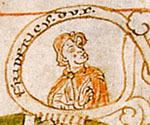Buried Walburg Abbey | Mother Agnes of Germany Name Frederick Duke | |
 | ||
Children Frederick I, Holy Roman Emperor, Conrad, Count Palatine of the Rhine, Judith of Hohenstaufen Parents Agnes of Germany, Frederick I, Duke of Swabia Similar People Frederick I - Holy Roman E, Conrad III of Germany, Philip of Swabia, Henry IX - Duke of Bavaria, Henry VI - Holy Roman E | ||
Frederick II (1090 – 6 April 1147), called the One-Eyed, was Duke of Swabia from 1105 until his death, the second from the Hohenstaufen dynasty. His younger brother Conrad was elected King of the Romans in 1138.
Contents
Life
Frederick II was the eldest son of Duke Frederick I of Swabia and his wife Agnes of Waiblingen, a daughter of the Salian emperor Henry IV. He succeeded his father in 1105 and together with his brother Conrad continued the extension and consolidation of the Hohenstaufen estates. Frederick had numerous castles erected along the Rhine river and in the Alsace region.
The Hohenstaufen brothers supported King Henry V in the conflict with his father Emperor IV; Frederick also accompanied him on his campaign against King Coloman of Hungary in 1108. In 1110 he and Henry V embarked on an expedition to Italy, where in Rome Henry enforced his coronation by Pope Paschal II. In turn, the emperor appointed Conrad Duke of Franconia and both brothers German regents when he left for his second Italian campaign in 1116. On the other hand, the rise of the Hohenstaufens began to upset rivalling princes like Archbishop Adalbert of Mainz, who loathed the supporters of Henry V.
About 1120 Frederick married Judith, a daughter of Duke Henry IX of Bavaria and member of the powerful House of Welf. Their first son Frederick was born in 1122.
Upon the death of Emperor Henry V in 1125, the Salian dynasty became extinct. Frederick II, Henry's nephew, stood for election as King of the Romans with the support of his younger brother Conrad and several princely houses. However, he lost in the tumultuous round of elections, led by Archbishop Adalbert of Mainz, to the Saxon duke Lothair II. Frederick at first rendered homage to the new king, however, he refused the feudal oath and insisted on the inheritance of the Salian family estates along the Middle Rhine.
At the 1125 Hoftag diet in Regensburg, the king officially requested the surrender of the Salian possessions. After he imposed an Imperial ban on the Hohenstaufens, the conflict erupted between Frederick and his supporters, and Lothair: encouraged by Archbishop Adalbert and several princes, the king occupied Hohenstaufen lands in Upper Lorraine and Alsace. However, an attack by Welf forces on the Swabian core territory failed, like the siege of Nuremberg by Lothair in 1127. Frederick relieved the siege and moreover gained the support from his brother Conrad, who had just returned from a pilgrimage to the Holy Land. During the fighting, Frederick lost an eye, whereafter he was no longer eligible as German king.
In December 1127 Conrad declared himself King of the Romans, while the next year Duke Frederick II occupied the Salian city of Speyer. The attempt of Duke Henry X of Bavaria to capture his brother-in-law Frederick during the negotiations failed. However, afterwards the supporters of Lothair won a number of victories both in Germany and in Italy. Speyer (1129), Nuremberg (1130) and Ulm (1134) were captured; moreover Frederick's consort Judith of Bavaria died in 1130. His second wife, Agnes of Saarbrucken, was a niece of his old enemy Adalbert of Mainz; Frederick married her about 1132.
After Lothair was crowned emperor in 1133, Frederick saw himself stuck between the Saxon and Bavarian forces. He eventually submitted to him in the spring of 1135 at Bamberg. Both were finally reconciled and Emperor Lothair renounced further attacks against the Hohenstaufens. After Lothair's death in 1137 and the following election of Conrad as King of the Romans, Frederick supported his brother in the struggle with the Welfs. According to Otto of Freising, Frederick was "so faithful a knight to his sovereign and so helpful a friend to his uncle that by valor he supported the tottering honor of the realm, fighting manfully against its foes..."
Duke Frederick II died in 1147 at Alzey. He was buried at the Benedictine abbey of Walburg in Alsace. His son Frederick succeeded him as Swabian duke and was elected German king (as Frederick Barbarossa) in 1152.
Marriage and children
With Judith of Bavaria (1103- 22 February 1131), daughter of Henry IX, Duke of Bavaria:
With Agnes of Saarbrucken (d. c. 1147), daughter of Frederick, Count of Saarbrucken:
